 Become a BirdSafe Pittsburgh volunteer this Sunday. Meet at the National Aviary, 100 Arch Street, on Sunday April 13, noon-to-2:00pm to learn what to do.
Become a BirdSafe Pittsburgh volunteer this Sunday. Meet at the National Aviary, 100 Arch Street, on Sunday April 13, noon-to-2:00pm to learn what to do.
Questions? Email Matt Webb at birdsafepgh@gmail.com
Click here for more information.
 Become a BirdSafe Pittsburgh volunteer this Sunday. Meet at the National Aviary, 100 Arch Street, on Sunday April 13, noon-to-2:00pm to learn what to do.
Become a BirdSafe Pittsburgh volunteer this Sunday. Meet at the National Aviary, 100 Arch Street, on Sunday April 13, noon-to-2:00pm to learn what to do.
Questions? Email Matt Webb at birdsafepgh@gmail.com
Click here for more information.
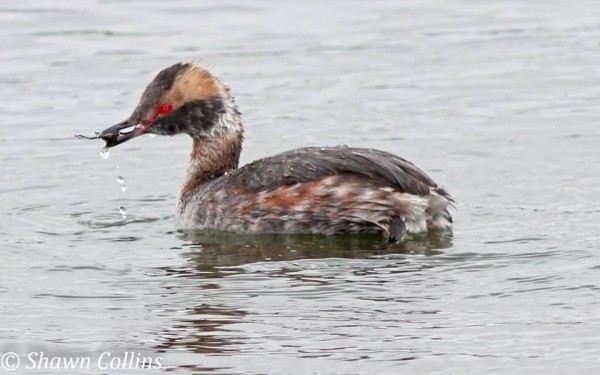
I mentioned last month that ring-billed gulls in breeding plumage have red rimmed eyes. Horned grebes go a step further. Their eyes are not only red-rimmed but the eyes themselves are red with a red line from eye to bill. They look like they’ve been on a binge.
Shawn Collins photographed this horned grebe in March when it was partway into breeding plumage.
When they’re finished molting they’re even more colorful but it’s harder to see their eyes.
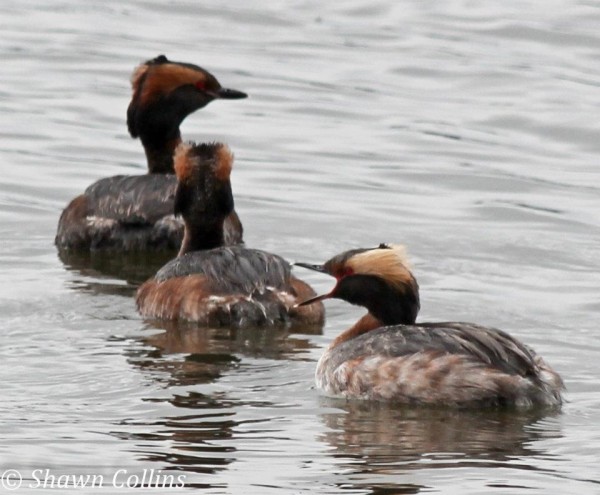
Last Sunday there were lots of horned grebes at Moraine State Park and they continue this week on regional lakes and rivers, migrating to their breeding grounds in Canada.
Look at their heads. Yes, they have “horns.”
(photos by Shawn Collins)
p.s. Horned grebes (Podiceps auritus) also breed in Europe and Asia where their English name is “Slavonian grebe.”
9 April 2014
Because I live in the city, I have to leave home to hear frogs calling. Though there are streams and a wetland in Schenley Park, the wetland is too recently restored and probably too isolated to have spring peepers. The park is surrounded by dense city neighborhoods and all of its water flows into a mile-long culvert that takes it to the Monongahela River. Where would frogs and fish come from? Not from downstream.
So I was delighted to hear spring peepers (Pseudacris crucifer) by the Sunken Garden Trail at Moraine State Park last Sunday, 6 April 2014. I made a point of sitting near the wetland, surrounded by their sound. Hundreds of them called in front of me but I couldn’t see even one because they’re so small and good at hiding. The video above (from Wisconsin) shows how tiny they are.
As a group the peepers were almost deafening but I heard two wood frogs and a single creaking sound among them. It sounded like a western chorus frog but it was probably an angry spring peeper. Wikipedia says, “As in other frogs, an aggressive call is made [by spring peepers] when densities are high. This call is a rising trill closely resembling the breeding call of the southern chorus frog.”
The video below gives you an idea of what I heard. Listen for the quacking of wood frogs at the beginning.
Jeepers creepers, do you hear the peepers?
Update: Check the comments for places where readers have heard peepers in the City!
(videos from YouTube)
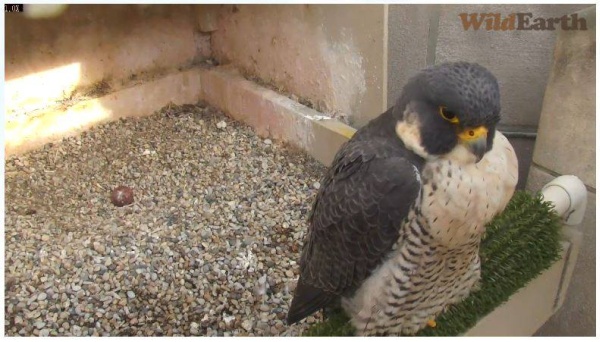
Today’s post is long but with eight nest sites there’s a lot of peregrine news in Pittsburgh. Some sites are exciting, others are boring (incubation), but that’s par for the course in early April.
Cathedral of Learning, University of Pittsburgh: We have the best falconcam ever at this site but only sad news to watch. At 15 years old, Dorothy laid one egg on March 20 and then stopped. She was egg bound but expelled it on the night of March 29-30. E2 continues to court and bring her food. Dorothy stands over the egg but never incubates. For now she waits. See her here.
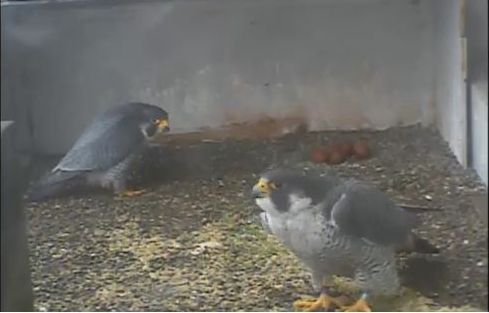
Gulf Tower, Downtown Pittsburgh: This nest exchange snapshot sums up the happy status at Gulf Tower right now. After two years on a short building on the other side of town, the peregrines came home to Gulf where we can watch them on camera. We’ve confirmed this pair is Dori (banding name “Mary Cleo,” Akron, 2007) and Louie (Cathedral of Learning, 2002) who last nested here in 2011. This spring Dori laid 5 eggs March 10 to 19 and began incubation midday March 17 just after her fourth egg, so we expect hatching to begin April 19 to April 21. We’ll zoom in the camera soon so you can watch for pips. See them here online. (*Donate at the link so we can get a better camera! Mark your donation for “Conservation and Field Research Department” and write “Gulf Tower camera” in the comments.)
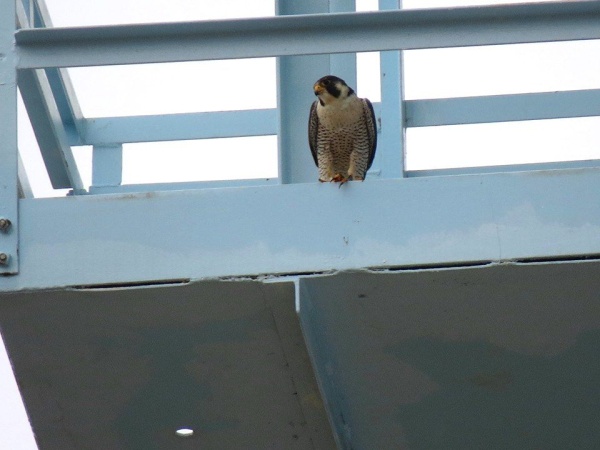
Green Tree water tower: Green Tree has had a complete changeover in resident adults this year. Last year Dorothy and E2’s daughter Blue was here with an immature unbanded male. This year Shannon Thompson confirmed the female is unbanded and the male has bands. On April 1 Leslie Ferree captured this photo of one of the adults hiding his/her legs. The pair has been very active, eggs are in progress, but so are intruders. Over the weekend Jill Dunmire noticed the male is missing three primary wing feathers, probably because of a fight. Photographers, please visit this site. Let’s identify the male. Click here for directions.

Neville Island I-79 Bridge: This bridge was over the top with excitement last Sunday. Anne Marie Bosnyak witnessed an intruder scuffle (right over her head!), a food exchange, and e-chupping from the likely nest location. The last time she saw the pair mate was on March 31 so they are probably on eggs. Who knew it could be so exciting? Click here for information on where to watch, though it might be boring now with incubation underway.
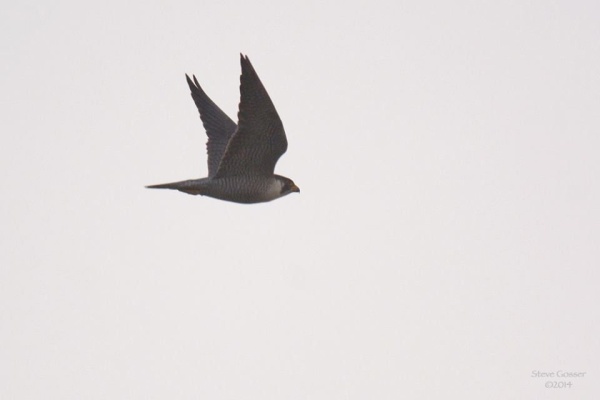
Tarentum Bridge: Speaking of boring, only one bird has been visible at a time at Tarentum since the third week of March. Observers usually see the female, Hope (from Hopewell, VA, 2008). If this pair is on the same schedule as last year the eggs will hatch a few days after Gulf Tower’s, around April 22 to 24. But this is only speculation.
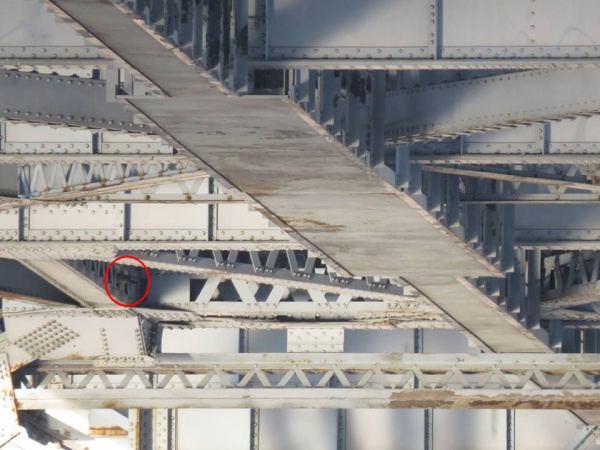
McKees Rocks Bridge: There’s no news from this site except: On March 31 Leslie Ferree photographed a peregrine looking into the holes in the bridge structure. Was it looking for a pigeon meal or visiting its own nest? See the tiny red circle above. (update: Leslie Ferree answers my “Is it the nest?” question in the comments below.)
Monaca/Beaver bridges: This elusive pair has chosen the big Monaca-to-Beaver railroad bridge as their home. They were seen copulating on February 23 and flying around the bridge on March 29, but other than that there’s no news from here.
Westinghouse Bridge: No peregrine news at this site but plenty of people news: A woman went missing under the bridge and a firefighter was killed by a train during the search. Then our keen observer, John English, hurt his foot and hasn’t been able to visit. Please visit if you get a chance.
April’s both exciting and boring. It’s a good time to get out and watch.
(photo credits: Cathedral of Learning: National Aviary falconcam, Gulf Tower: National Aviary falconcam, Green Tree water tower: Leslie Ferree, Neville Island Bridge: Robert Stovers on Wikimedia Commons, Tarentum falcon: Steve Gosser, McKees Rocks Bridge: Leslie Ferree)
Gulls always nest on the ground, right?
Wrong! There’s one gull species in North America, migrating through western Pennsylvania this week, that nests in trees.
Bonaparte’s gulls seem to lead double lives. In the winter they’re just like any other gull on the coast, loafing near humans on the beach and skimming the ocean to catch small fish. Their beautiful moth-like flight sets them apart but otherwise they’re unremarkable. In winter they look like this:
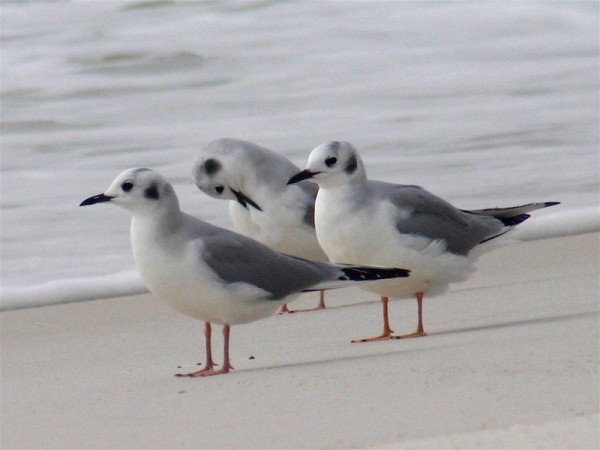
In the spring they molt into sharp black, gray and white breeding plumage.
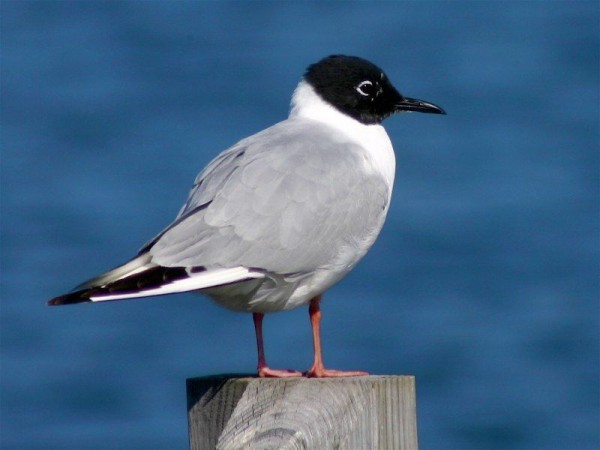
But even before their heads turn black they migrate north, passing through Pittsburgh along the Ohio River. Their peak numbers often occur on the same day every year, April 10 at Dashields Dam.
When the Bonaparte’s get home to the boreal forest they eat insects on the wing, build their nests in conifers, and become so secretive that they’re hard to find. That’s the other half of their double lives.
Here come the “Bonnies.” They’re heading for the trees.
(nest photo by Dr. Matthew Perry, Pawtuxent Wildlife Research Center USGS. Click on the image to see the original. Bonaparte’s gull portraits by Chuck Tague)
You may be wondering how far the eaglecam is from the Pittsburgh Hays bald eagles’ nest and how it works out there in the woods.
This video from the Pennsylvania Game Commission shows how the eaglecam was installed last December and all the gear that makes it run.
I don’t know who climbed 75 feet up the camera tree but he was surely brave!
The man on the ground arranging the solar panels and batteries is Bill Powers of PixController. He installed Pittsburgh’s two falconcams, too.
Many thanks, Bill, for all you do!
(YouTube video from the Pennsylvania Game Commission)

There’s a cheetah on your hood and he has really big teeth.
Maybe he was too close for their lenses. 😉
Thanks to Cris Hamilton for sharing her February trip to Africa.
(photo by Cris Hamilton at Ndutu, Tanzania, February 2014)
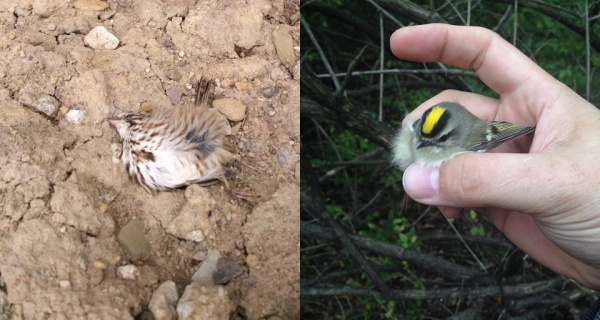
Here’s the project I’ve been praying for. I hope you can help.
As I know too well, windows are a huge cause of death in birds. Each year up to 1 billion birds die by hitting windows in the U.S. and some of them are Pittsburgh’s juvenile peregrines. The problem is especially acute during spring and fall migration when thousands of birds pass through North American cities in the dark. Half are killed outright. The others are stunned and need time to recuperate. The song sparrow above died in a window-strike at WQED. The stunned golden-crowned kinglet, rescued by Shawn Collins, is showing his yellow crown because he has a big headache!
Across North America innovative cities are working to make their towns safer for birds. Now, thanks to a coalition of seven organizations(*), Pittsburgh is poised to join Toronto, Minneapolis-St.Paul, San Francisco and a host of others to make our town “bird safe.” The project begins this month.
For six weeks during migration — mid-April through May — BirdSafe Pittsburgh needs volunteers to walk portions of downtown daily for an hour or two in the early morning, looking for stunned or dead birds. Stunned birds will be rescued. All birds will be counted.
If you have free time in the early morning, and especially if you work Downtown, this project is for you!
Meet at the National Aviary, 100 Arch Street, on Sunday 13 April 2014, noon-to-2:00pm to learn what to do. Questions? Email Matt Webb at birdsafepgh@gmail.com
I hope you can help.
Let’s make Pittsburgh BirdSafe!
(photo of window-killed song sparrow by Kate St. John. photo of collision-stunned golden-crowned kinglet by Shawn Collins)
(*) The coalition includes: American Bird Conservancy, National Aviary, Audubon Society of Western Pennsylvania, Carnegie Museum of Natural History, Powdermill, Animal Rescue League Wildlife Center, Green Building Alliance, and Chatham University.
Yesterday afternoon around 5:00pm the third and final egg hatched at the Pittsburgh Hays bald eagle nest. This happened during rush hour so a lot of us missed it … or did you stay late at work to watch?
Click on the photo above to watch the eaglet emerge from his egg.
An hour later all the eaglets are visible as Mom feeds the oldest chick.
Her actions reminded me that we will soon see a characteristic of bald eagle family life that’s quite different from peregrines’ — the tendency for the oldest eaglets to thrive and the youngest to die, sometimes killed by their siblings.
Bald eagle eggs hatch asynchronously so each new eaglet is two days smaller than the previous chick. Bald eagle parents feed the chick that asks for food, and since the oldest is bigger and more active he’s fed more than his siblings. Eagle chicks are aggressive toward their siblings and the parents don’t breakup the fights. The third chick often starves. Cornell’s Birds of North America Online describes it this way, referring to a study in Saskatchewan:
Hatching asynchrony and differential growth leads to differential mass in siblings, facilitating competition and fratricide. Sibling competition and mortality is greatest early in nestling period, when size differences are greatest. Third-hatched chicks in Saskatchewan nests received little food and usually starved.
This behavior is quite different from the peregrines’ lifestyle. Peregrine falcon eggs hatch almost simultaneously so all the chicks are close in age and size. The last chick may be smaller at first because he hatches two days later, but peregrine chicks are not aggressive and their parents make sure everyone eats at every feeding. Mother peregrines “chup” to their babies to encourage them to stand up and be fed. Click here see how effective (and cute) this is.
For now there are three eaglets at the Pittsburgh Hays eaglecam … but be prepared for the day when there might be only two.
(videos and snapshots from the Pittsburgh Hays eaglecam)
This morning I heard the sound of a lonesome dove.
When seeking a mate male mourning doves call like the ones in this video. Those who’ve found true love don’t need to sing because the cooing is a solicitation call, not a territorial defense.
Unmated males perch-coo from the heights as loudly as they can, “Ladies, I’m available.” It’s amazingly loud considering they don’t even open their mouths. A few have already begun calling in my neighborhood but the peak time will be late April through June.
Males also use flap-glide flight to attract female attention. Taking off with exaggerated wing-claps, they fly up above the trees and rooftops, then spiral down with stiff wings held slightly below their bodies. From a distance their silhouettes resemble kestrels or sharp-shinned hawks. They’ve fooled me more than once. Here’s my attempt at what they look like, gliding from left to right:
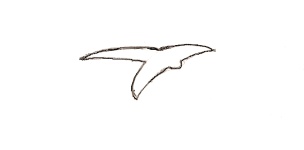
Today sunrise is at 6:49am so a lot of us are awake before the perch-cooing begins, but lonesome doves can be annoying in June when they start calling at 5:00am.
Quiz! Test your “birding by ear” skills with this video. In addition to the mourning dove there are at least seven other species singing in the background. Who are they?
(video by Carl Gerhardt, musicofnature.org via YouTube. Silhouette drawing by Kate St. John)